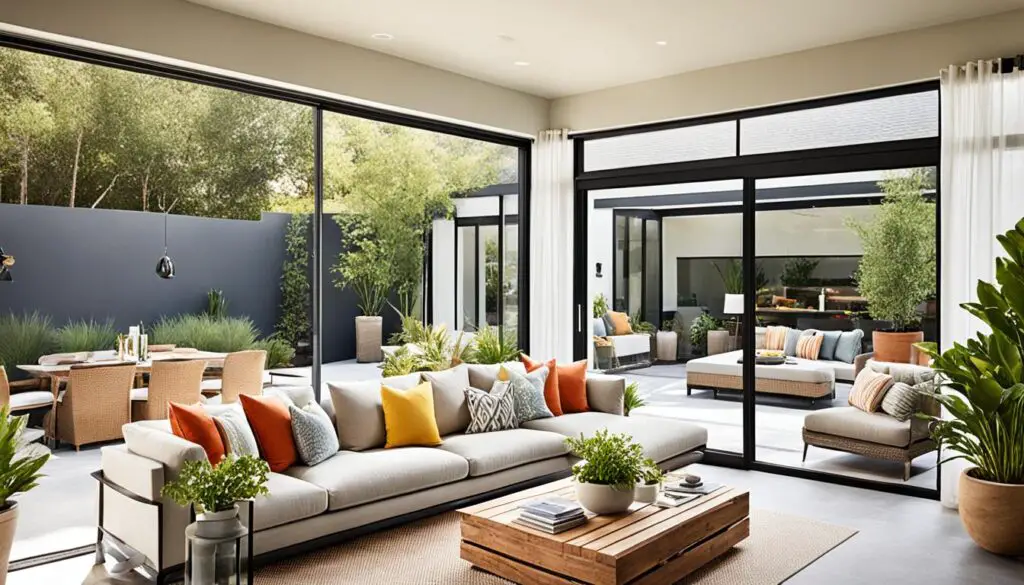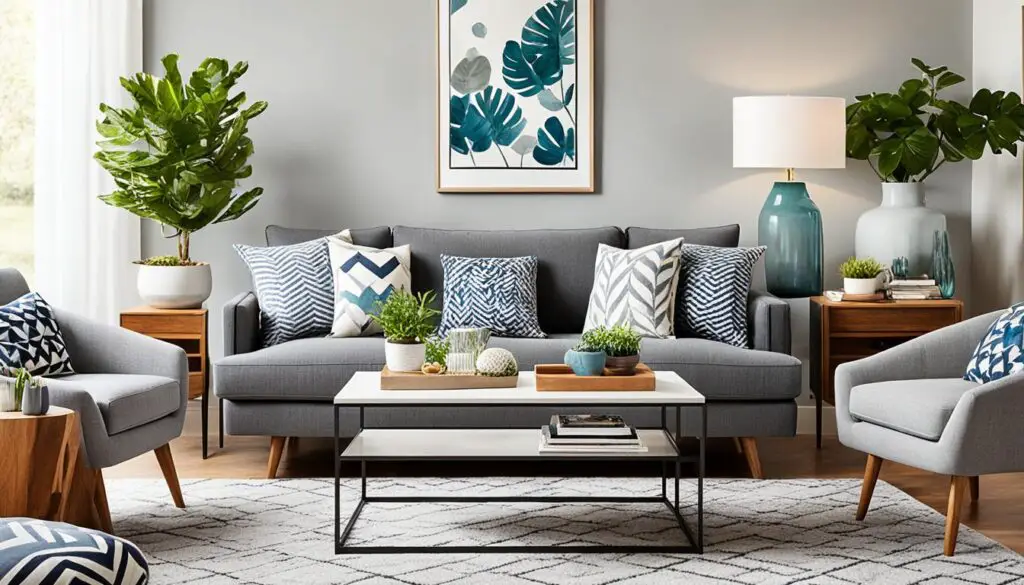Discover the art of embracing imperfection with wabi sabi living room inspiration. It’s rooted in the Japanese aesthetic, which finds beauty in the imperfect and transient. This design philosophy turns spaces into tranquil havens by celebrating natural textures, muted tones, and simplicity.
Imagine living rooms with weathered wood, handcrafted ceramics, and earthy hues like soft grays and warm browns. Architects like Alena Valyavko and Bettina Kiehnle show how to blend rustic materials with clean lines. They create spaces that feel both authentic and uplifting.
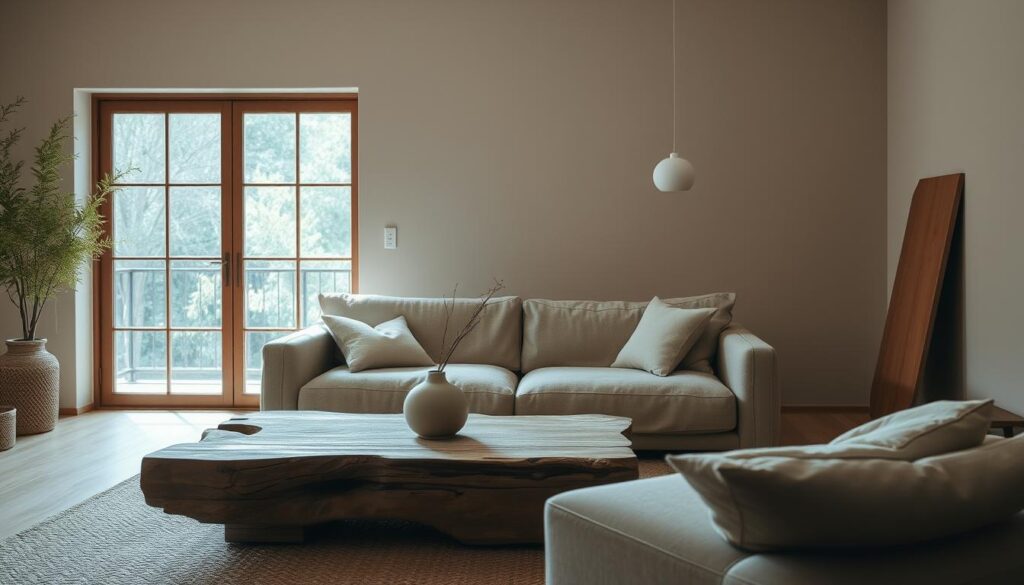
From Zen Retreats with open layouts to Cozy Clarity with layered textiles, each idea offers a pathway to a serene sanctuary. Embracing imperfections, like cracked pottery or uneven wood grains, adds soul to your space. Let this guide introduce you to a design style that values calm, connection to nature, and the quiet elegance of the imperfect.
Understanding Wabi Sabi: The Beauty of Imperfection
Wabi-sabi is a Japanese philosophy that teaches us to love life’s short moments. It encourages us to see flaws as part of life’s journey. This way of thinking makes spaces feel real and full of life, without the need for perfectness.
As scholar Leonard Koren said, “Wabi-sabi is an acceptance of transience as beauty.”
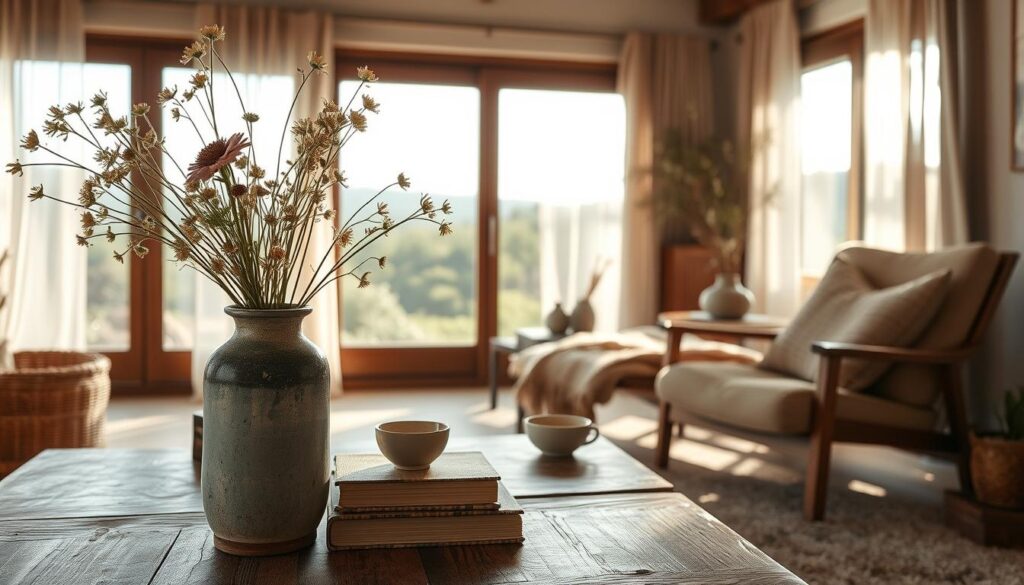
The Philosophy Behind Wabi Sabi
This philosophy comes from Zen practices, where monks found beauty in simplicity and change. Tea ceremonies celebrated items with imperfections, like cracked bowls and uneven surfaces. These imperfections showed that beauty can be found in life’s irregularities.
Things like weathered wood or faint tea stains became signs of authenticity.
Key Principles of Wabi Sabi Living
- Embrace asymmetry: Irregular shapes in pottery or uneven furniture joints add organic charm.
- Age as art: Cracked ceramics or faded textiles tell stories of use and history.
- Minimal essentials: pared-down decor focuses on items with purpose and history.
How Wabi Sabi Transforms Spaces
These principles turn rooms into places where flaws are celebrated. A weathered side table or a hand-thrown vase becomes a centerpiece. Spaces feel like a sanctuary, where every mark has a story.
Such serene home decor brings calm, valuing comfort over the latest trends.
Embracing Natural Materials in Your Living Room
Transform your space with natural elements decor that highlights rustic elegance. Wabi-sabi design loves materials that tell stories through texture and imperfection. Wood, textiles, and earthy accents bring harmony to your space.
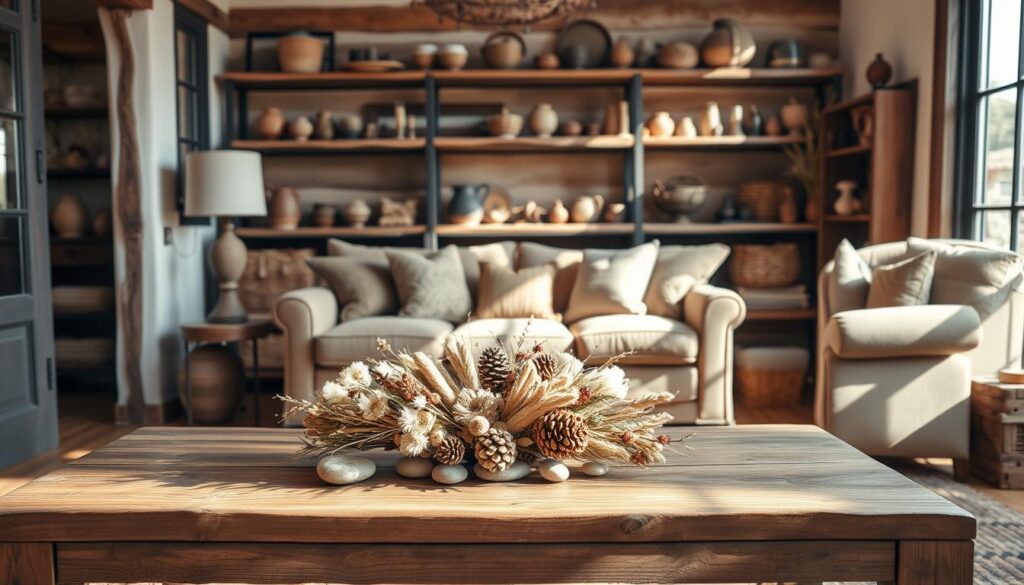
Wood: A Timeless Element
Choose wood with visible history—knotted planks, reclaimed beams, or driftwood accents. Aged oak or cedar furniture shows the beauty of wear. Wide-plank flooring lets grain patterns shine.
- Reclaimed wood beams add structural warmth
- Weathered tables emphasize organic character
- Driftwood shelves blend nature and function
Textiles that Speak to Nature
Linen, hemp, and wool textiles bring softness and earthy tones. Choose handwoven throws, unbleached cotton curtains, or jute rugs. These fabrics adapt to your space and evolve in texture over time.
| Material | Use | Aesthetic |
|---|---|---|
| Linen | Curtains, upholstery | Lightweight, breathable |
| Handwoven wool | Rugs, blankets | Cozy, textural depth |
| Jute | Rugs, wall hangings | Earthy, grounded feel |
Adding Stone and Clay Accents
Bring the outdoors in with terracotta pots, cement planters, or brick accents. Clay vessels hold plants beautifully, while stone tiles add durability. Mix textures like river rocks or slate for visual interest.
Materials like terracotta and natural stone align with sustainability—reusing and repurposing reduces waste. Let each piece develop its own patina as part of its charm.
Choosing a Color Palette for Wabi Sabi
Creating a serene home decor space starts with colors that mirror nature’s quiet beauty. The Japanese aesthetic of wabi-sabi thrives on muted tones that feel timeless and unpretentious. Think of colors found in soil, moss, and weathered wood—each hue a whisper of the natural world.
Muted and Earthy Tones
Nature’s palette offers endless inspiration. Opt for:
- Muted greens like sage or olive for walls
- Earthy browns inspired by clay or aged wood
- Soft grays that mimic mist or river stones
Atelier Ellis’s Zen Paint Colors collection offers paints made from natural minerals, perfect for this style.
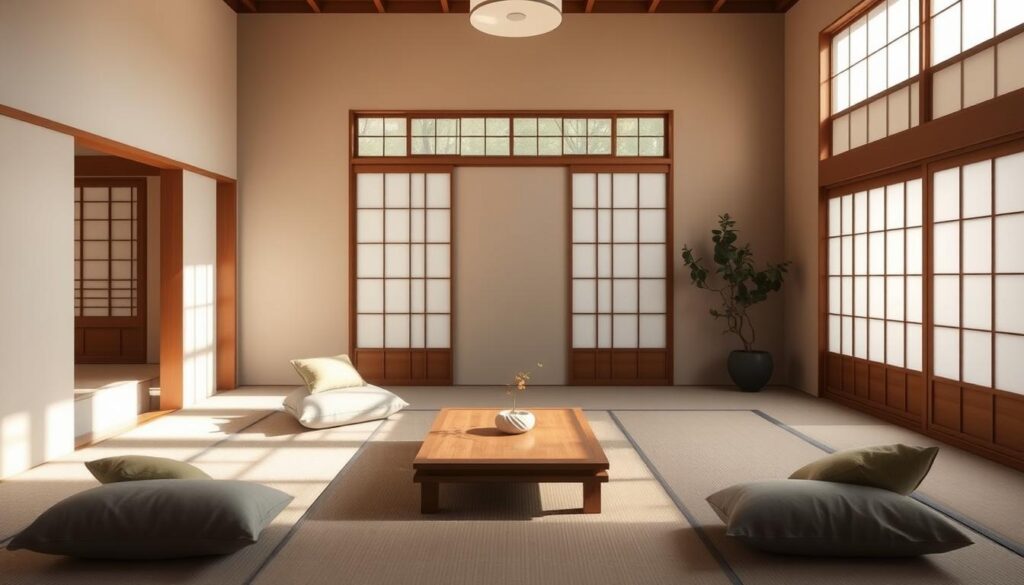
Adding Depth with Layering Colors
| Base Colors | Layering Accents |
|---|---|
| Muted terracotta | Dark charcoal trim |
| Soft sand | Deep espresso wood accents |
Pair a warm gray wall with a faded indigo throw pillow or a terracotta vase. This layering avoids monotony while staying true to the Japanese aesthetic.
The Role of Textures in Color Selection
Textures transform how colors interact. Rough linen in beige absorbs light differently than a smooth terracotta pot. A matte clay vase (beige) placed next to a glossy gray ceramic bowl creates visual harmony without clash. Let natural light shift the perception of colors throughout the day.
Furniture Selection: Merging Function and Form
Choosing furniture that reflects Wabi-Sabi’s core values starts with pieces that tell stories through their history and use. Minimalistic interior design thrives here, where every item serves a purpose while embracing imperfections. Simplicity in decor means prioritizing clean lines and materials authenticity over ornate details.
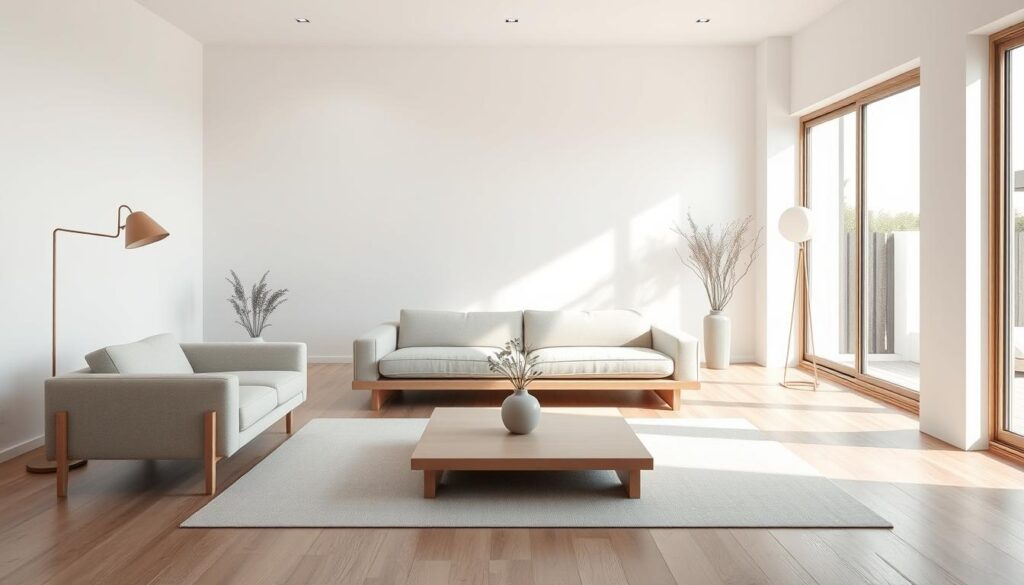
“A well-designed room should feel like a living thing, evolving with time.”
| Furniture Type | Wabi-Sabi Features | Why It Works |
|---|---|---|
| Aged Leather Sofa | Patina, soft edges | Time-worn elegance |
| Reclaimed Wood Table | Imperfections, natural texture | Celebrates history and function |
| Handwoven Rattan Chair | Handmade imperfections | Adds organic warmth |
Vintage and Antique Pieces
Antique chests, timeworn leather armchairs, or weathered side tables bring character. Look for handcrafted wooden stools with visible tool marks or ceramic accents with deliberate asymmetry. These items add depth without demanding attention.
The Power of Simplicity in Design
Low-profile sofas or minimalist shelving with clean lines reduce visual noise. Opt for:
- Unpainted wood showing grain patterns
- Textured fabrics like burlap or unbleached linen
- Single-functional items (e.g., a plain wooden bench)
Upcycling Furniture for a Unique Touch
Transform thrifted finds by:
- Distressing edges of cabinets with sandpaper
- Reupholstering chairs with handwoven textiles
- Adding iron brackets to repair cracks
Pairing these pieces with open space layouts lets each item breathe, aligning with Wabi-Sabi’s balance of emptiness and purpose.
Creating Cozy and Inviting Spaces
Turn your living room into a cozy sanctuary with serene home decor. It should mix simplicity with comfort. Wabi sabi living room inspiration loves textures that feel good to touch and show organic beauty. Start by adding materials that look lived-in but still have a purpose.
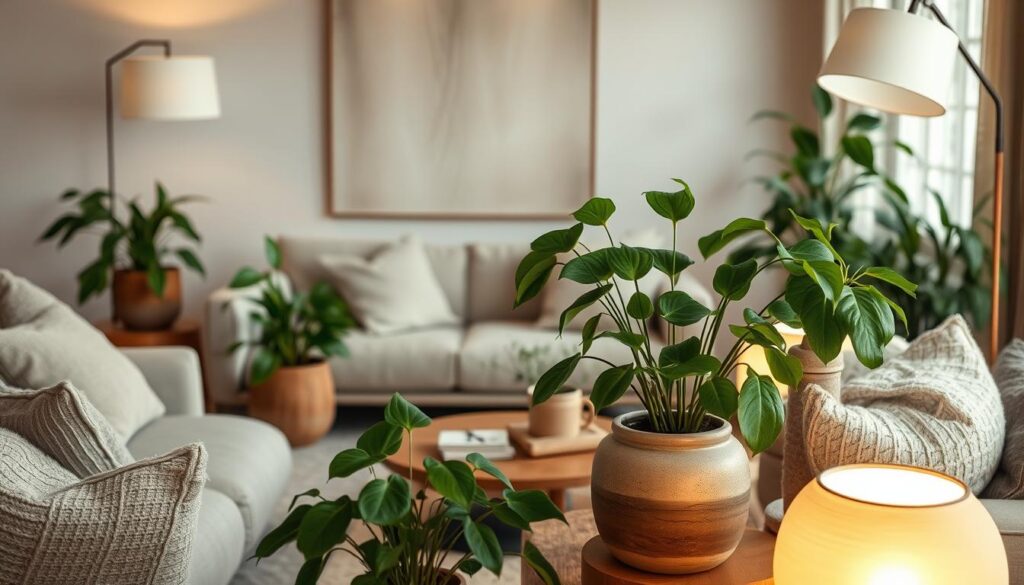
Use soft fabrics to make spaces feel like home. Choose hand-loomed wool throws, frayed linen curtains, or vintage velvet cushions. These add warmth and make spaces feel inviting. A favorite quilt on a sofa makes everyone want to stay longer.
- Tip: Mix fabrics like burlap, jute, and hand-spun cotton to layer without matching patterns.
- Add a distressed leather pouf or a handwoven basket for storage that doubles as decor.
Use rugs with a weathered look to define areas and add depth. A faded kilim with a jute mat underfoot looks great together. Look for wool runners with uneven fringes or vintage Moroccan rugs with soft colors. Overlap them to show the natural flow of nature.
Bring in plants to make spaces lively. A bonsai tree in a clay pot or a snake plant in a cracked vase adds life. Choose plants like ZZ plants or dracaenas for their toughness and rustic look. Group small succulents in terracotta pots to look like they belong together.
Match imperfection with purpose, like a reclaimed wood side table next to a hand-thrown ceramic lamp. These details make a simple space feel alive and changing, showing the essence of wabi sabi living room inspiration.
Wabi Sabi Lighting Ideas to Enhance Ambiance
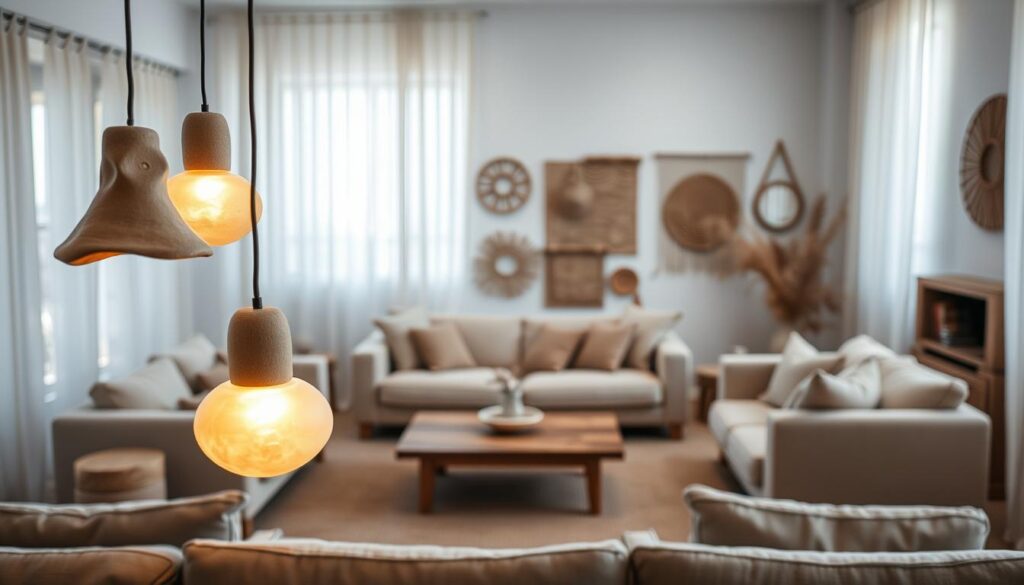
Lighting is key to any space’s soul. Wabi Sabi design uses it to bring calm and connect us to nature. For serene home decor, choose fixtures that reflect the Japanese aesthetic of simplicity and imperfection.
Natural light works best with sheer curtains that filter the sun. This lets shadows play on walls. Mirrors placed right reflect daylight softly, linking the room to the outdoors. This light and shadow dance is a nod to Wabi Sabi’s love for fleeting beauty.
- Legro Pendant Lamp: Textured beige shade on a walnut base for soft pools of light.
- Harley Pendant Lamp: Teal curved shade with a speckled finish creates ocean-inspired calm.
- Ekeby Ceramics Lamp: Handmade ceramic bases with muted tones blend earth and light.
Candles in handmade holders—like natural stone or weathered metal—add warmth to nights. Pick holders with unique textures, like the DLSixYi spherical stone pendant lights. They celebrate organic imperfection. Place them to highlight wall textures or art, not in bright clusters.
Keep this calm by dusting fixtures weekly with a soft cloth. Stay away from harsh cleaners to protect materials like unglazed clay or oxidized metals. Let light change with the seasons, just like Wabi Sabi values life’s gentle shifts.
Curating Decor with Purpose and Intention
Change your living space by picking decor that shows purpose. Wabi-sabi’s curated simplicity shines when each item has a story or brings calm. Focus on three main areas to mix minimalistic interior design with heart.
Meaningful Art and Objects
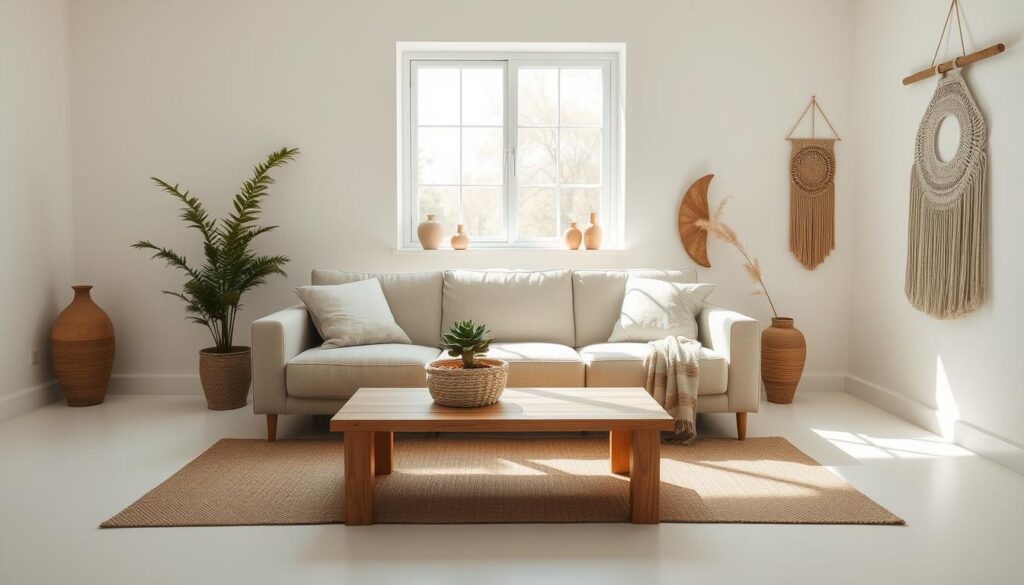
- Sumi-e ink paintings capturing fleeting moments
- Weathered driftwood sculptures or terracotta planters
- Black-and-white photography of natural textures like tree bark or river stones
Handmade and Artisan Creations
Handcrafted items bring realness. Look for:
- Ceramic bowls with visible potter’s fingerprints
- Handwoven baskets with uneven weaves
- Unfinished wood sculptures showing raw material beauty
Artisans like Indian craft collectives make items that fit wabi-sabi, like hand-loomed textiles from rural cooperatives.
Minimizing Clutter for Clarity
Get rid of things you don’t need. Try these tips:
- Keep only items that spark joy or serve a purpose
- Reserve 20-30% of surfaces as empty zones
- Rotate seasonal decor like autumn leaves in glass jars
Less is more—this way, every item has a special meaning.
Designing a Wabi Sabi Reading Nook
Create a peaceful spot in your living room with wabi sabi inspiration. A cozy reading nook blends rustic charm with usefulness. It becomes a quiet place for reflection.
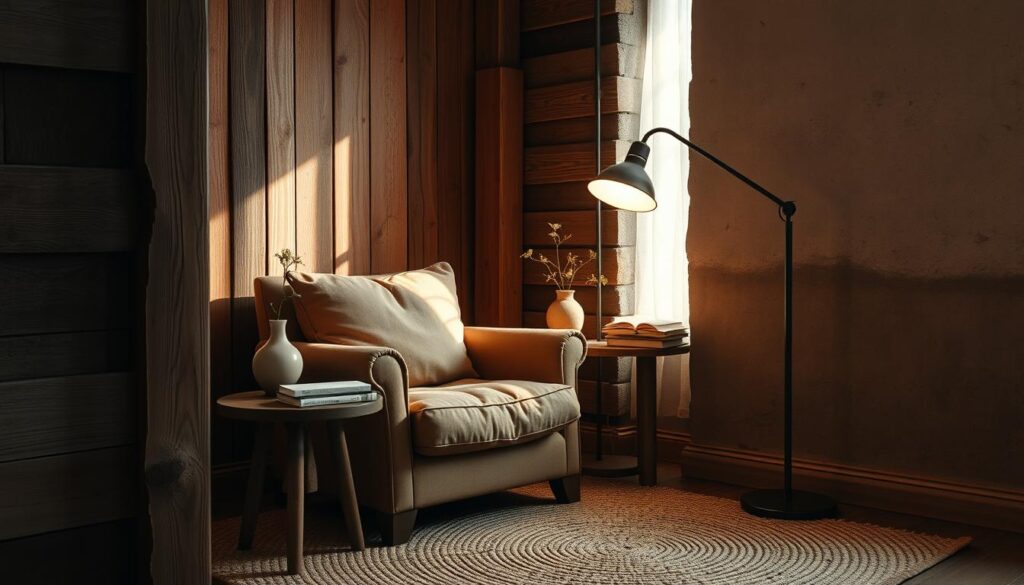
Choosing the Right Location
Find a spot where light is natural but privacy is welcome. Look for corners near big windows or areas away from busy paths. Anca A.’s designs show how plants or woven screens can define the space without walls.
Here are some tips for choosing the right spot:
- Place near a window for daylight and views of nature
- Avoid high-traffic zones to maintain calm
- Use potted ferns or bamboo screens as organic dividers
Comfortable Seating Options
Choose furniture that’s both historic and cozy. Wabi-sabi seating loves imperfections:
| Item | Description | Material |
|---|---|---|
| Aged leather chair | Patinaed surface | City Bed Frame’s walnut-finished bases |
| Hand-loomed cushions | Undyed organic cotton or wool | Chajul Wool Rug textures |
| Vintage reading chair | Linen upholstery | Reupholstered with soft, frayed edges |
Ideal Lighting for Relaxation
Use different light sources to create a cozy mood. Try these options:
- Adjustable floor lamps with ceramic bases
- Handmade paper sconces for soft glow
- Candles in handmade pottery with visible clay textures
Add a Chajul Wool Rug and an Ester Wool Throw for warmth. Let the imperfections in materials like uneven baskets or textured throws bring wabi-sabi to life.
Integrating Indoor-Outdoor Living Concepts
Merging indoor and outdoor spaces deepens the wabi sabi spirit. Using natural elements like plants and stone connects our living areas to nature. This approach brings out the beauty of imperfection and harmony with the outdoors, key to wabi sabi living room inspiration.

Designers suggest that connecting with the outdoors brings peace. Here’s how to blend spaces:
Utilizing Natural Views
Use sheer fabrics to frame windows and show off views. Place sofas to look out at gardens. Change your decor with the seasons to reflect outdoor changes. Even city folks can use potted herbs on windowsills to add greenery.
Incorporating Outdoor Elements Inside
Bring nature inside to transform your space. Try these ideas:
| Element | How to Use | Example |
|---|---|---|
| Bonsai | Place in clay pots for organic texture | Miniature trees in mismatched containers |
| Stone | Arrange river rocks or driftwood as art pieces | A basket of smooth stones by a window |
| Wood | Use reclaimed planks for shelves or tables | A driftwood shelf holding hand-thrown pottery |
Creating a Seamless Transition
- Use the same flooring material inside and outside (e.g., wood planks extending onto a patio)
- Hang Japanese lanterns on porches to mirror indoor lighting
- Plant herbs in clay pots both indoors and on a balcony
These steps make the living room a space where nature’s rhythms guide the design. It celebrates simplicity and connection to the environment.
Inspiring Real-Life Wabi Sabi Living Rooms
See how homes mix wabi-sabi into everyday areas. These examples show how to bring imperfect beauty and rustic elegance into different spaces.
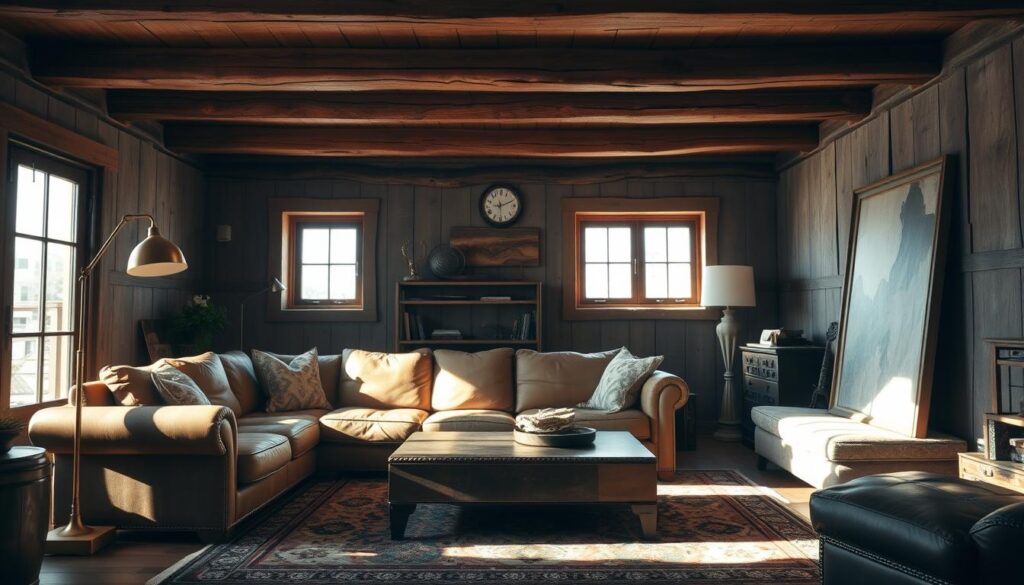
| Case Study | Key Features | Design Elements |
|---|---|---|
| Minimalist Spaces | Sparse layouts, neutral tones | Weathered wood floors, hand-thrown ceramics, linen curtains |
| Rustic Charm | Handcrafted textures, natural imperfections | Exposed stone accents, handwoven baskets, vintage pottery |
| Urban Wabi Sabi | Industrial meets organic | Rusted metal shelves, reclaimed wood, potted succulents |
Rustic elegance is seen in spaces with weathered beams and handmade pottery. Urban areas mix industrial concrete with plants for a modern touch. Each space uses textures like burlap or ceramics to show imperfect beauty.
- Minimalist: Neutral tones with strategic texture contrasts
- Rustic: Layered earth tones and reclaimed materials
- Urban: Blending raw surfaces with soft natural fabrics
These examples show wabi-sabi fits any style. A distressed table or handwoven rugs can turn a space into a calm retreat.
Tips for Maintaining a Wabi Sabi Living Room
Keeping a Wabi Sabi space is a constant conversation between care and acceptance. These steps help your room grow beautifully, staying true to its philosophy of finding beauty in life’s imperfections.
Embracing Change Over Time
Let your space grow with you. Scratches on wooden surfaces or faded upholstery tell stories of daily life. Take photos to celebrate these changes.
A well-loved kintsugi vase or a weathered chair develops character, not flaws. Resist the urge to replace items—embrace their evolution.
Cleaning Techniques that Preserve Character
Clean gently to protect textures. Use microfiber cloths and mild, natural cleaners on wood, avoiding abrasive sponges. For textiles, opt for handwashing delicate fabrics or air-drying to preserve softness.
A marble coffee table’s patina or woven rattan pendants gain depth over time—cleaning should enhance, not erase, these details.
Rotating Decor for Fresh Perspectives
Refresh your space seasonally with simplicity in decor. Swap out a neutral throw for a muted green option in spring, or rearrange floating shelves to highlight new handmade pieces.
Curated simplicity means rotating a few items at a time—like a boho tapestry or potted plant—to keep the room alive without disrupting its core aesthetic. Let these shifts mirror nature’s cycles, not trends.
FAQ
What is wabi-sabi design?
Wabi-sabi design is a Japanese philosophy that loves imperfection and natural aging. It aims to create calm, real spaces. These spaces show simplicity and a strong bond with nature.
How can I incorporate wabi-sabi elements in my living room?
Use natural materials like wood and stone. Choose soft colors. Pick vintage or handmade furniture. Focus on designs that celebrate imperfections.
What are some key principles of wabi-sabi living?
Key principles include accepting change and natural aging. Find beauty in flaws. Embrace simplicity and truth in your space.
How does wabi-sabi transform a living space?
Wabi-sabi makes spaces feel real and welcoming. It creates a calm, natural beauty. This beauty is more important than perfectness.
What colors are commonly used in wabi-sabi design?
Soft browns, sage greens, terracottas, and smoky grays are common. These colors reflect nature and avoid bright, synthetic ones.
How do I select furniture that fits the wabi-sabi aesthetic?
Look for vintage or antique pieces with age and character. Choose simple designs. Consider upcycling to add authenticity and comfort.
What types of textiles work well in a wabi-sabi living room?
Use organic materials like raw linen, unbleached cotton, and wool. Choose textures that add warmth and depth.
How can I make my wabi-sabi space feel more inviting?
Add soft, tactile textiles and layer rugs for warmth. Plants can bring life to the room. Aim for a cozy atmosphere that invites relaxation.
What lighting is best for a wabi-sabi living room?
Use natural light and soft, warm lighting. Candles can enhance the ambiance, highlighting textures and creating a soothing atmosphere.
Should decor in a wabi-sabi living room tell a story?
Yes! Choose meaningful art and handmade items. Each piece should have personal significance and show craftsmanship.
How can I create a reading nook within my wabi-sabi space?
Find a quiet corner with good lighting and comfy seating. Use rugs or plants to define the area. Add natural materials for a cozy feel.
What are some tips for integrating nature into my living room?
Use natural views with thoughtful window treatments. Bring outdoor elements inside with branches or stones. Create a seamless transition between indoors and outdoors.
How can I maintain the wabi-sabi aesthetic in my living room over time?
Accept natural changes and use gentle cleaning. Rotate decor seasonally to keep your space lively and connected to nature.

